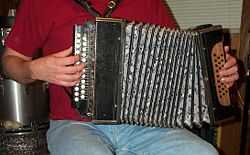Garmon
 |
|
| Classification | Free reed aerophone |
|---|---|
| Related instruments | *Accordion |
The garmon (Russian: гармонь) is a kind of Russian button accordion, a free-reed wind instrument. A garmon has two rows of buttons on the right side, which play the notes of a diatonic scale, and at least two rows of buttons on the left side, which play the primary chords in the key of the instrument as well as its relative harmonic minor key. Many instruments have additional right-hand buttons with useful accidental notes, additional left-hand chords for playing in related keys, and a row of free-bass buttons, to facilitate playing of bass melodies.
The garmons can be of two major classes: unisonoric, meaning that each button plays the same note or chord when the bellows is being expanded as it does when compressed, and bisonoric, in which the note depends on the direction of the bellowswork. Examples of unisoniric type are livenka (ливенка, after Livny, Oryol Oblast)[1] and Khromka (Russian: Хромка, for "chromatic"). Bisonoric garmons are, e.g., Tula accordion (Russian: Тульская гармонь, after Tula) and talyanka (тальянка, "Italian")
The garmon is also known by the names garmoshka (Russian: гармошка) and garmonika (Russian: гармоника) .
The garmon is an important musical instrument for Azeri[2][3][4] and Hamshen folk and popular music.
Contents |
Keyboard arrangement
Although reduced and expanded versions are widely available, the standard arrangement (known as "25 × 25") is as follows:
- 25 treble buttons in two rows: Three diatonic octaves plus three accidentals.
- 25 bass buttons in three rows: Two rows of eight buttons, with bass notes and chords; one free-bass row.
The treble keyboard is arranged so that a scale may be played by alternating between the two rows. The low and high octaves have identical fingering, while the middle octave differs. The three accidental notes are arranged so as to mirror the position of the left-hand chords that contain them.

The bass keyboard is arranged so that the principal chords for the major key are in the outer row, placed in circle of fifths order; the principal chords for the harmonic minor key are in the middle row; free bass notes are in the inner row. One free bass accidental note is included.
Some Garmons (often seen in Azeri music,) have a small right-hand piano keyboard and a unique bass keyboard of buttons laid out similar to piano keys. One row of buttons plays the "white" notes, while another row of "black" buttons has spaces mirroring the pattern of sharps and flats on the right-hand piano keys. [5][6]The Nardin Gallery, has pictures and videos of these.
Garmoni
Garmoni(accordion) can hardly be considered a Georgian folk instrument. It came to Georgia from Europe, namely, from Russia in the 1830s and immediately became popular among folk musicians. It is especially popular in Tusheti, where it is used as an accompanying instrument (together with vocals) and also as a solo instrument.
Buzika
Buzika is a kind of small accordion that is widespread especially among the mountain inhabitants of Georgia. Georgian accordion with its timbre does not sound like other countries’ accordions. It is considered to be women’s instrument and that is why a bride was often presented with Buzika at the time of engagement. It was widely used during the national holidays, merriments, and different parties. Consequently, Buzika’s repertoire mainly consists of song and dance melodies. Buzika was often used for performing solo melodies, but sometimes it was played in an ensemble with “Doli” (a drum), “Daira”, “Diplipito” and “Panduri”. Its sound is in good voice of Duduki, Salamuri, Panduri.
Tsiko-Tsiko
Tsiko-tsiko came to Georgia from Europe in the 1830s. Tsiko-Tsiko mainly accompanies dances.
See also
- Music of Central Asia
References
- ↑ Livenka (Russian)
- ↑ http://www.seveneighths.com/rahman_asadollahi.htm
- ↑ http://www.richardsilverstein.com/tikun_olam/2006/04/30/rahman-asadollahi-master-of-azeri-garmon/
- ↑ http://www.azer.com/aiweb/categories/magazine/91_folder/91_articles/91_shahriyari.html
- ↑ http://nardingallery.blogspot.com/2007/03/garmon.html
- ↑ http://nardingallery.blogspot.com/2007/03/answering-some-questions-about-garmon.html
External links
- Squeezebox, an open repository of squeezebox knowledge on Wikia.
- http://www.hangebi.ge/garmonien.htm
- The Nardin Gallery, (from Iran) has many photos of rare Garmons and accordions.
|
||||||||